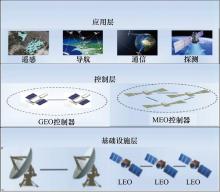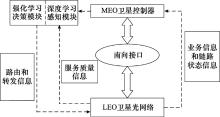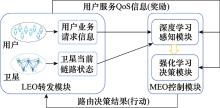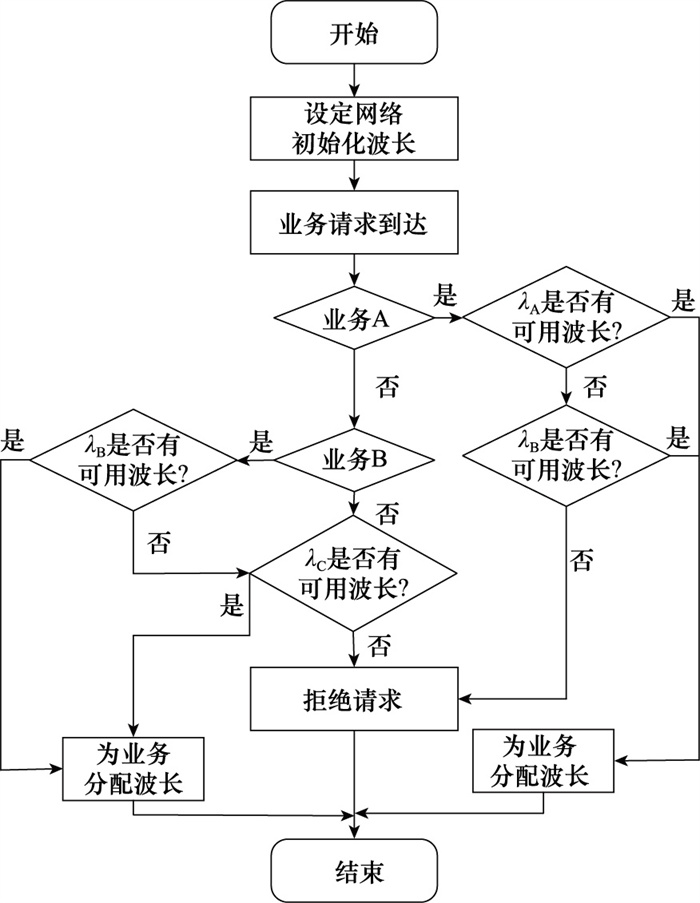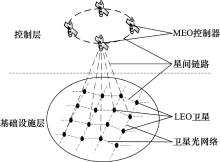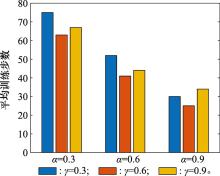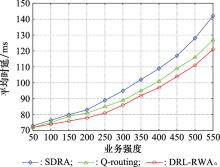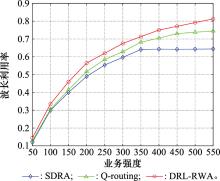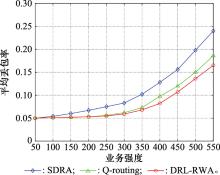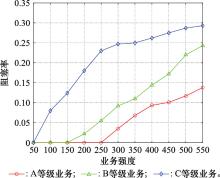Systems Engineering and Electronics ›› 2023, Vol. 45 ›› Issue (1): 264-270.doi: 10.12305/j.issn.1001-506X.2023.01.31
• Communications and Networks • Previous Articles
A wavelength routing algorithm for optical satellite network based on deep reinforcement learning
Xin LI, Yongjun LI, Shanghong ZHAO
- Information and Navigation College, Air Force Engineering University, Xi'an 710003, China
-
Received:2021-07-04Online:2023-01-01Published:2023-01-03 -
Contact:Xin LI
CLC Number:
Cite this article
Xin LI, Yongjun LI, Shanghong ZHAO. A wavelength routing algorithm for optical satellite network based on deep reinforcement learning[J]. Systems Engineering and Electronics, 2023, 45(1): 264-270.
share this article
| 1 |
LIU X F , YANG L , CHEN Q , et al. An analytic method of wavelength requirements in dynamic optical satellite networks[J]. IEEE Communications Letters, 2020, 24 (11): 2569- 2573.
doi: 10.1109/LCOMM.2020.3009211 |
| 2 |
DONG Q R , CHEN T , GAO S J , et al. Progress of research on satellite-borne laser communication technology[J]. Chinese Optics, 2019, 12 (6): 1260- 1270.
doi: 10.3788/co.20191206.1260 |
| 3 |
CHEN S Z , SUN S H , KANG S L . System integration of terrestrial mobile communication and satellite communication—the trends, challenges and key technologies in B5G and 6G[J]. China Communications, 2020, 17 (12): 156- 171.
doi: 10.23919/JCC.2020.12.011 |
| 4 |
YANG Y , ZHU L D , MAO X , et al. The spread spectrum GFDM schemes for integrated satellite-terrestrial communication system[J]. China Communications, 2019, 16 (12): 165- 175.
doi: 10.23919/JCC.2019.12.013 |
| 5 |
LI Y , LI K X , WANG J H , et al. Massive MIMO transmission for LEO satellite communications[J]. IEEE Journal on Selected Areas in Communications, 2020, 38 (8): 1851- 1865.
doi: 10.1109/JSAC.2020.3000803 |
| 6 |
KUANG Q Q , ZHAN L , GU Z C , et al. High-energy passively mode-locked raman fiber laser pumped by a CW multimode laser[J]. Journal of Lightwave Technology, 2015, 33 (2): 391- 395.
doi: 10.1109/JLT.2014.2375339 |
| 7 |
SUN Z X , XIAO R L , SU Z R , et al. High single-mode stability tunable in-series laser array with high wavelength-spacing uniformity[J]. Journal of Lightwave Technology, 2020, 38 (21): 6038- 6046.
doi: 10.1109/JLT.2020.3005828 |
| 8 |
ERDOGAN E , ALTUNBAS I , KURT G K , et al. Site diversity in downlink optical satellite networks through ground station selection[J]. IEEE Access, 2021, 9, 31179- 31190.
doi: 10.1109/ACCESS.2021.3059641 |
| 9 |
ZHENG Z L , HUA N , ZHONG Z Z , et al. Time-sliced flexible resource allocation for optical low earth orbit satellite networks[J]. IEEE Access, 2019, 7, 56753- 56759.
doi: 10.1109/ACCESS.2019.2913441 |
| 10 |
LYRA N K , EFREM C N , KOUROGIORGAS C I , et al. Optimizing the ground network of optical MEO satellite communication systems[J]. IEEE Systems Journal, 2020, 14 (3): 3968- 3976.
doi: 10.1109/JSYST.2019.2945838 |
| 11 |
GONG S L , SHEN H , ZHAO K L , et al. Network availability maximization for free-space optical satellite communications[J]. IEEE Wireless Communications Letters, 2020, 9 (3): 411- 415.
doi: 10.1109/LWC.2019.2958804 |
| 12 |
刘庆利, 姚俊飞, 刘治国. 基于多业务的卫星光网络波长路由算法研究[J]. 系统仿真学报, 2017, 29 (8): 1780- 1787.
doi: 10.16182/j.issn1004731x.joss.201708018 |
|
LIU Q L , YAO J F , LIU Z G . Research on wavelength routing algorithm based on multi-service in satellite optical network[J]. Journal of System Simulation, 2017, 29 (8): 1780- 1787.
doi: 10.16182/j.issn1004731x.joss.201708018 |
|
| 13 |
SUN X , CAO S Z . A routing and wavelength assignment algorithm based on two types of LEO constellations in optical satellite networks[J]. Journal of Lightwave Technology, 2020, 38 (8): 2106- 2113.
doi: 10.1109/JLT.2020.2965185 |
| 14 |
YANG Q L , TAN L Y , MA J . Analysis of crosstalk in optical satellite networks with wavelength division multiplexing architectures[J]. Journal of Lightwave Technology, 2010, 28 (6): 931- 938.
doi: 10.1109/JLT.2009.2035527 |
| 15 | ZHOU R , HE L W , TANG C C , et al. SDN path enhancement algorithm based on multi-objective constraint genetic algoithm[J]. Computer Technology and Development, 2019, 7, 17- 22. |
| 16 |
GUO Q , GU R T , DONG T , et al. SDN-based end-to-end fragment-aware routing for elastic data flows in LEO satellite-terrestrial network[J]. IEEE Access, 2019, 7, 396- 410.
doi: 10.1109/ACCESS.2018.2885473 |
| 17 | 吴艳. 基于流量分类的智能SDN路由优化技术研究[D]. 杭州: 浙江工商大学, 2019. |
| WU Y. Research on intelligent SDN routing optimization technology based on traffic classification[D]. Hangzhou: Zhejiang Gongshang University, 2019. | |
| 18 | 石晓东, 李勇军, 赵尚弘, 等. 基于SDN的卫星网络多QoS目标优化路由算法[J]. 系统工程与电子技术, 2020, 42 (6): 1395- 1401. |
| SHI X D , LI Y J , ZHAO S H , et al. Multi-QoS objective optimization routing algorithm of satellite network based on SDN[J]. Systems Engineering and Electronics, 2020, 42 (6): 1395- 1401. | |
| 19 |
CHENG Z J , ZHANG X N , LI Y C , et al. Congestion-aware local reroute for fast failure recovery in software-defined networks[J]. Journal of Optical Communications and Networking, 2017, 9 (11): 934- 944.
doi: 10.1364/JOCN.9.000934 |
| 20 |
PICCHI R , CHITI F , FANTACCI R , et al. Towards quantum satellite internetworking: a software-defined networking perspective[J]. IEEE Access, 2020, 8, 210370- 210381.
doi: 10.1109/ACCESS.2020.3038529 |
| 21 |
LI T X , ZHOU H C , LUO H B , et al. SERvICE: a software defined framework for integrated space-terrestrial satellite communication[J]. IEEE Trans.on Mobile Computing, 2018, 17 (3): 703- 716.
doi: 10.1109/TMC.2017.2732343 |
| 22 | 石晓东, 李勇军, 赵尚弘, 等. 软件定义卫星光网络蚁群优化波长路由技术[J]. 红外与激光工程, 2020, 49 (10): 211- 218. |
| SHI X D , LI Y J , ZHAO S H , et al. Ant colony optimization routing and wavelength technology for software-defined satellite optical network[J]. Infrared and Laser Engineering, 2020, 49 (10): 211- 218. | |
| 23 | STAMPA G, ARIAS M, SANCHEZ-CHARLES D, et al. A deep-reinforcement learning approach for software-defined networking routing optimization[J]. 2017, http://arxiv.org/abs/1709.0708. |
| 24 |
YU C H , LAN J L , GUO Z H , et al. DROM: optimizing the routing in software-defined networks with deep reinforcement learning[J]. IEEE Access, 2018, 6, 64533- 64539.
doi: 10.1109/ACCESS.2018.2877686 |
| 25 | BOYAN J A , LITTMAN M L . Packet routing in dynamically changing networks: a reinforcement learning approach[J]. Advances Neural Information Processing Systems, 1994, 6 |
| 26 | 靳晓晗. 基于深度强化学习的无线多跳网络路由算法研究[D]. 北京: 中国科学院大学, 2020. |
| JIN X H. Research on deep reinforcement learning based routing algorithm for wireless multihop networks[D]. Beijing: University of Chinese Academy of Sciences, 2020. | |
| 27 | 魏德宾, 刘健, 潘成胜, 等. 卫星网络中基于多QoS约束的蚁群优化路由算法[J]. 计算机工程, 2019, 45 (7): 114- 120. |
| WEI D B , LIU J , PAN C S , et al. Ant colony optimization routing algorithm based on multi-QoS constraints in satellite networks[J]. Computer Engineering, 2019, 45 (7): 114- 120. | |
| 28 | QIU C , YAO H , YU F R , et al. Deep Q-learning aided networking, caching, and computing resources allocation in software-defined satellite-terrestrial networks[J]. IEEE Trans.on Vehicular Technology, 2019, 68 (6): 5871- 5883. |
| 29 | GUO A D, ZHAO C L, XU F M, et al. LEO satellite routing algorithm in software defined space terrestrial integrated network[C]// Proc. of the International Symposium on Communications and Information Technologies, 2017: 1-6. |
| 30 | KIM S, SON J, TALUKDER A, et al. Congestion prevention mechanism based on Q-learning for efficient routing in SDN[C]// Proc. of the International Conference on Information Networking, 2016. |
| [1] | Xinkang SONG, Shanghong ZHAO, Xiang WANG, Shaowei HAO. Collaborative construction and embedding strategy of aviation information network service function chain [J]. Systems Engineering and Electronics, 2022, 44(11): 3556-3563. |
| [2] | Xiaodong SHI, Yongjun LI, Shanghong ZHAO, Weilong WANG, Xingyu WANG. Multi-QoS objective optimization routing algorithm of satellite network based on SDN [J]. Systems Engineering and Electronics, 2020, 42(6): 1395-1401. |
| [3] | ZHENG Wei, LIU San-yang, KOU Xiao-li. Energy efficient routing algorithm based on ant colony optimization for wireless sensor network [J]. Journal of Systems Engineering and Electronics, 2009, 31(8): 1993-1996. |
| Viewed | ||||||
|
Full text |
|
|||||
|
Abstract |
|
|||||
